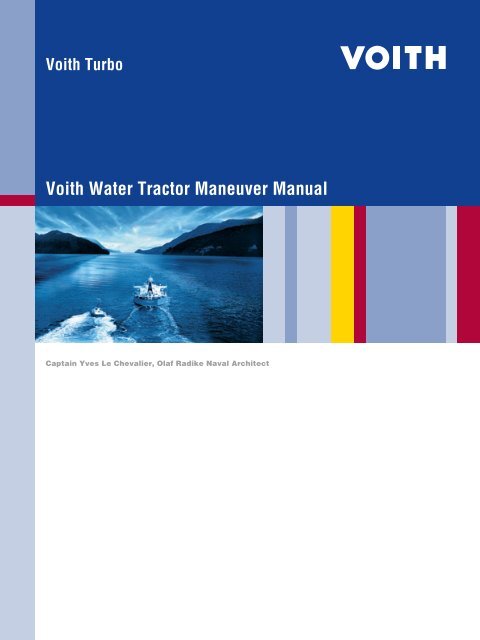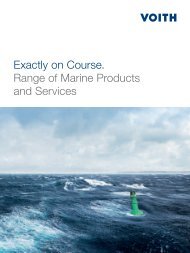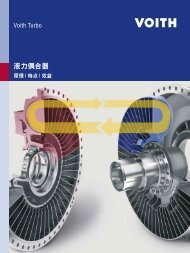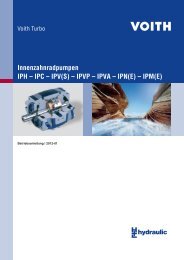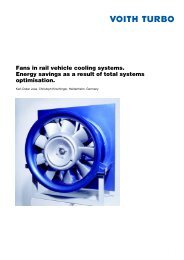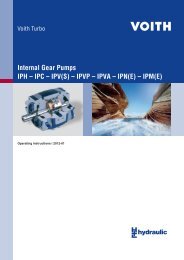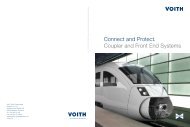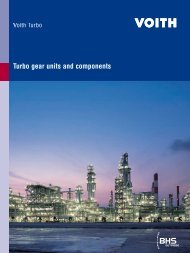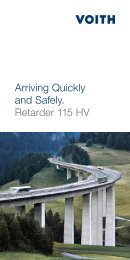Voith Water Tractor Maneuver Manual - Voith Turbo
Voith Water Tractor Maneuver Manual - Voith Turbo
Voith Water Tractor Maneuver Manual - Voith Turbo
Create successful ePaper yourself
Turn your PDF publications into a flip-book with our unique Google optimized e-Paper software.
<strong>Voith</strong> <strong>Turbo</strong><br />
<strong>Voith</strong> <strong>Water</strong> <strong>Tractor</strong> <strong>Maneuver</strong> <strong>Manual</strong><br />
Captain Yves Le Chevalier, Olaf Radike Naval Architect
Introduction<br />
Introduction<br />
Note that due to the forward VSP the<br />
VWT is steered by moving the bow.<br />
The <strong>Voith</strong> <strong>Water</strong> <strong>Tractor</strong><br />
<strong>Maneuver</strong> <strong>Manual</strong> is an educational<br />
tool mainly intended<br />
for tug masters to explain the<br />
principles of ship handling<br />
and maneuvering.<br />
It describes the various possibilities<br />
for safe and effective<br />
use of a <strong>Voith</strong> <strong>Water</strong> <strong>Tractor</strong>.<br />
<strong>Voith</strong> <strong>Water</strong> <strong>Tractor</strong>:<br />
Revolution in Shiphandling<br />
The True <strong>Tractor</strong><br />
Configuration<br />
In the early 1950’s the German<br />
company <strong>Voith</strong> developed the <strong>Voith</strong><br />
<strong>Water</strong> <strong>Tractor</strong> concept in response<br />
to tug losses through girting and<br />
being overrun under a ship’s bow.<br />
The fundamental innovation was<br />
that the <strong>Voith</strong> Schneider Propellers<br />
were arranged forward and the<br />
towing point aft of the tug’s pivot<br />
point to avoid the unstable equilibrium<br />
of forces existing on conventional<br />
as well as on ASD tugs on<br />
which both the towing point and<br />
the propulsion are aft.<br />
When mane uvering a VWT with<br />
bow-positioned VSPs, the most<br />
noticeable difference is that it<br />
steers into a turn rather than the<br />
stern swinging outside the turning<br />
circle as is the case with sternpropelled<br />
vessels.<br />
True VWT configuration<br />
The introduction of such tractor<br />
tugs, generally known as <strong>Voith</strong><br />
<strong>Water</strong> <strong>Tractor</strong>s, with their free<br />
running speeds of up to 15 knots<br />
and bollard pulls of up to 100 tons,<br />
has revolutionized worldwide shiphandling<br />
in respect to safety and<br />
efficiency.
Concept<br />
5<br />
4<br />
VWT key components<br />
Logical arrangement of the<br />
VWT key components<br />
1. The VSPs are located in the<br />
foreship, with free inflow and<br />
outflow in all directions. The<br />
thrust forces act ahead of the<br />
tug’s axis of rotation.<br />
2. A protective guard is fitted<br />
underneath the propellers. It<br />
creates a nozzle effect which<br />
increases the propeller thrust. In<br />
addition the guard protects the<br />
propeller blades against running<br />
aground and supports the vessel<br />
when docking.<br />
3. The hull is an integrated part of<br />
the system, creating lift for the<br />
indirect steering and ensuring<br />
low resistance in transit.<br />
4. A skeg, which is shaped to maximize<br />
the lifting forces, is located<br />
below the aft body and provides<br />
effective steering and braking<br />
3<br />
1<br />
6<br />
2<br />
assistance for the tow. The skeg<br />
shifts the center of lateral resistance<br />
aft, thus increasing leverage<br />
between propeller thrust and<br />
pivot point. It also ensures adequate<br />
course stability when<br />
running either bow or skeg first.<br />
5. The towing gear (staple and<br />
winch) is located aft of the vessel’s<br />
centre of rotation (pivot<br />
point).<br />
6. The VWT is operated from the<br />
control stand in the wheelhouse.<br />
Depending on the vessel size<br />
one or several synchronized<br />
control stands may be used. The<br />
steering system is usually connected<br />
mechanically to the<br />
propellers to permit direct control<br />
of the system and avoid the<br />
risk of steering system failure.<br />
The CAN bus-controlled electrical<br />
steering system developed<br />
together with the Bosch Rexroth<br />
Group provides the highest<br />
safety standard.<br />
The <strong>Voith</strong> <strong>Water</strong> <strong>Tractor</strong> is a<br />
functional vessel with integrated<br />
<strong>Voith</strong> Schneider Propellers (VSP).<br />
2<br />
3
<strong>Voith</strong> <strong>Water</strong> <strong>Tractor</strong>:<br />
Sensitive Thrust Control in any Direction<br />
Propellers with control rods in machinery room Split-type steering console<br />
Thrust vector diagram<br />
<strong>Voith</strong> <strong>Water</strong> <strong>Tractor</strong>s utilize the<br />
unique cycloidal propulsion system<br />
(<strong>Voith</strong> Schneider Propeller), representing<br />
state-of-the-art technology<br />
in shiphandling.<br />
<strong>Voith</strong> <strong>Water</strong> <strong>Tractor</strong>s escort tankers<br />
and assist ships and tows in and<br />
out of harbors and waterways and<br />
into and out of docks and berths.<br />
All this is accomplished with minimum<br />
expenditure of time and<br />
ensuring maximum safety for the<br />
escorted/towed vessel, the assisting<br />
tractor(s), their crews, and the<br />
port facilities. With its cycloidal<br />
propulsion system the <strong>Voith</strong> <strong>Water</strong><br />
<strong>Tractor</strong> can thrust directly in any<br />
direction without any undesired<br />
steering moment. It allows the<br />
maneuvering of large vessels into<br />
confined channels and docks with<br />
optimum utilization of power and<br />
thrust.<br />
The thrust is controlled according<br />
to the Cartesian coordinates:<br />
The pitch levers control the magnitude<br />
of longitudinal thrust and the<br />
wheel controls the magnitude of<br />
transversal thrust.
Fig. 1<br />
Fig. 2<br />
Fig. 3<br />
Fig. 4<br />
10 8<br />
10 8<br />
10 8<br />
10 8<br />
Use of wheel and pitch levers<br />
6<br />
6<br />
6<br />
6<br />
4<br />
4<br />
4<br />
4<br />
2<br />
2<br />
2<br />
2<br />
0 2 4 6 8 10<br />
0 2 4 6 8 10<br />
0 2 4 6 8 10<br />
0 2 4 6 8 10<br />
10<br />
8<br />
6<br />
4<br />
2<br />
10 86420<br />
10<br />
8<br />
6<br />
4<br />
2<br />
10 86420<br />
10<br />
8<br />
6<br />
4<br />
2<br />
10 86420<br />
10<br />
8<br />
6<br />
4<br />
2<br />
10 86420<br />
100%<br />
50<br />
0<br />
100%<br />
50<br />
0<br />
100%<br />
50<br />
0<br />
100%<br />
50<br />
0<br />
pitch levers full ahead or astern<br />
wheel at “zero”<br />
thrust ahead (astern) = 100 %<br />
transverse thrust = 0%<br />
100% 50 0<br />
50 100%<br />
pitch levers full ahead (astern)<br />
wheel approx. 5 port (starboard)<br />
thrust ahead (astern)<br />
approx. 55 %<br />
transverse thrust approx. 45 %<br />
100% 50 0<br />
50 100%<br />
pitch levers full ahead (astern)<br />
wheel at 10 port (starboard)<br />
thrust ahead (astern) = 25 %<br />
transverse thrust 75 %<br />
100% 50 0<br />
50 100%<br />
pitch levers at zero<br />
wheel at 10 port (starboard)<br />
thrust ahead (astern) = 0%<br />
transverse thrust 100%<br />
100% 50 0<br />
50 100%<br />
Fig. 1: With both pitch levers<br />
set to full ahead (pitch 10),<br />
the wheel changes the<br />
direction of thrust.<br />
This means that with the<br />
pitch levers set to full ahead<br />
or astern and the wheel set<br />
to zero the thrust ahead<br />
(astern) is 100%. The transverse<br />
thrust is 0%.<br />
Fig. 2: With the pitch levers<br />
set to full ahead (astern) and<br />
the wheel set to approx. 5<br />
port (starboard), the thrust<br />
ahead (astern) is approx.<br />
55%, the transverse thrust is<br />
approx. 45%.<br />
Fig. 3: With the pitch levers<br />
set to full ahead (10) (astern)<br />
and the wheel set to 10 port<br />
(starboard), the thrust ahead<br />
(astern) is 25% and the<br />
transverse thrust is 75%.<br />
Fig. 4: With pitch levers set<br />
to zero and the wheel set to<br />
10 port (starboard), the resulting<br />
thrust to the side is 100%.<br />
Lateral transition is generally<br />
done using the wheel which<br />
overrides longitudinal thrust.<br />
4<br />
5
<strong>Tractor</strong> Manouvers<br />
Example<br />
rpm pitch 10 pitch 8<br />
free running pulling<br />
1000 14.2 knots 50 tons<br />
950 13.5 knots 45 tons<br />
900 12.8 knots 40 tons<br />
800 11.4 knots 32 tons<br />
700 10.0 knots 25 tons<br />
600 8.5 knots 18 tons<br />
1. <strong>Tractor</strong> at work<br />
Pitch restriction must be applied for<br />
all towing operations.<br />
The tugmaster must control the<br />
engine speed in such a way as to<br />
ensure that the safety of the tug<br />
and crew is not endangered.<br />
The speed settings must be done in<br />
accordance with the requirements<br />
of the towing operation.<br />
Max. engine rpm about 100%<br />
Min. operating rpm about 60%<br />
Idle or stand-by rpm about 40%<br />
Control system<br />
The pitch restrictor must not be<br />
applied for free running<br />
In the event of the engine becoming<br />
overloaded, the engine speed will<br />
drop and the tugmaster must<br />
reduce the wheel and/or lever<br />
settings.<br />
Pitch settings<br />
Max. pitch pushing about 9<br />
Max. pitch pulling about 8<br />
Max. pitch free running about 10<br />
Causes of engine overload<br />
1. Wheel and/or pitch lever setting<br />
changed too fast.<br />
2. <strong>Maneuver</strong>ing without pitch<br />
restriction, 10 ahead, 10 astern.<br />
3. Retarding vessel with pitch<br />
levers set too high.<br />
4. Pulling with pitch settings<br />
greater than 8.<br />
5. Pushing with pitch settings<br />
than 9.<br />
To avoid engine overload during<br />
pulling and pushing, the pitch<br />
restrictor, located on the control<br />
stand, must be engaged.<br />
Engine overload will be indicated by:<br />
overload warning lights flashing<br />
at 110% power<br />
acoustic alarm on the VSP control<br />
stand.<br />
In the event of an overload alarm<br />
simply reduce the pitch until alarm<br />
switches off and subsequently<br />
increase pitch again.
10 86420246810<br />
10<br />
8<br />
6<br />
4<br />
2<br />
0<br />
2<br />
4<br />
6<br />
8<br />
10<br />
Wheel moves the bow Pitch levers move the stern<br />
Remark:<br />
Some <strong>Voith</strong> <strong>Water</strong> <strong>Tractor</strong>s are<br />
specially designed for high speed<br />
escorting. These VWTs are of the<br />
Fin First Design (Fin first), i. e. the<br />
fin (skeg) side is the bow and the<br />
free sailing is done fin first. The<br />
standard VWTs have the VSPs in<br />
the bow (VSP first), the free sailing<br />
is generally done VSP first. The<br />
descriptions “VSP first” and “Fin<br />
first” describe the starting course<br />
for the maneuvers.<br />
2. Running ahead (VSP first)<br />
Stay behind the wheel for this<br />
operation direction. For a right/left<br />
turn of the tractor turn the wheel to<br />
the right/left.<br />
3. Running astern (Fin first)<br />
Stay behind the wheel for this<br />
operation direction. For a right/left<br />
turn of the tractor turn the wheel to<br />
the right/left.<br />
4. Crash stop<br />
a) Standard:<br />
VSP- or Fin first: Pull the levers<br />
steadily to pitch 6 of opposite<br />
direction and slowly increase if<br />
necessary. Make sure wheel is<br />
set to “0”.<br />
b) Enhanced:<br />
VSP- or Fin first: Pull levers from<br />
10 to 0 and turn the wheel hard<br />
over to port (starboard) in order<br />
to stop the VWT at a right angle<br />
to its course. The remaining<br />
headway (sternway) is stopped<br />
by putting the pitch levers astern<br />
(ahead).<br />
Note:<br />
Crash stops as per 4.a) (levers only)<br />
result in a VWT stopping distance<br />
of approx. 1 x shiplength. Crash<br />
stops as per 4.b) result in a VWT<br />
stopping distance of approx. 0.5 x<br />
shiplength.<br />
10<br />
8<br />
6<br />
4<br />
2<br />
0<br />
2<br />
4<br />
6<br />
8<br />
10<br />
10 86420246810<br />
Note:<br />
If a rope or any other obstruction is<br />
picked up by a propeller, the emergency<br />
stop of the respective engine<br />
must be actuated immediately.<br />
Enhanced crash stop<br />
6<br />
7
a) Casting off/Unberthing in unrestricted space<br />
5. Casting off<br />
a) In unrestricted space VSP first.<br />
Turn the wheel in the direction to<br />
sheer off. At the same time push<br />
the port (starboard) lever ahead.<br />
c) Casting off/Unberthing sideways in<br />
restricted space<br />
b) In restricted space VSP first:<br />
First open the stern (pos 1) about<br />
1 meter from the quay and then<br />
turn the wheel in the direction to<br />
sheer off (pos 2). Set the pitch<br />
levers forward (pos 3).<br />
position 3<br />
b) Casting off/Unberthing in restricted space, VSP first<br />
position 1<br />
c) In restricted space sideways:<br />
When casting off to port with the<br />
VWT in very restricted space, set<br />
the outside lever forward, the<br />
inshore lever aft and the wheel to<br />
port. The turning moment (movement)<br />
produced by the opposite<br />
action of the two propellers is<br />
compensated by the action of<br />
the wheel. The vessel moves<br />
sideways. Also refer to “Coming<br />
alongside in restricted space<br />
sideways”.<br />
position 2
position 1<br />
position 2<br />
a) Berthing Fin first,<br />
restricted/unrestricted space<br />
6. Coming alongside<br />
position 3<br />
a) In unrestricted or restricted space.<br />
Fin first: Starting from position 1:<br />
Run Fin first with wheel at “0”,<br />
two hands at levers.<br />
Control the fin-side position with<br />
the levers in order to berth fin<br />
first without speed (pos 2).<br />
Hold the fin-side on position,<br />
make fast aft that side and turn<br />
wheel to come alongside (pos 3).<br />
Berthing Fin first,<br />
restricted /unrestricted space<br />
1<br />
b) Berthing VSP first,<br />
unrestricted space<br />
b) In unrestricted space VSP first:<br />
Starting from position 1: Turn the<br />
wheel to port and hold off the<br />
bow just before touching the<br />
quay. The VWT must come<br />
alongside at a higher speed than<br />
a stern-propelled craft. With<br />
insufficient speed the holding off<br />
the bow may reduce the forward<br />
motion excessively and thus<br />
prevent the VWT from reaching<br />
the quay. The remaining headway<br />
is stopped by putting the<br />
pitch levers astern.<br />
2<br />
3<br />
c) Berthing sideways<br />
c) In restricted space sideways:<br />
In a confined space and with<br />
twin propellers “crabbing” can<br />
be used. The inshore propeller is<br />
set ahead, the outside propeller<br />
astern and the wheel turned<br />
towards the bank until the vessel<br />
traverses. As a result of the<br />
nozzle effect of the propeller<br />
protection plate, the thrust of the<br />
propeller working astern is slightly<br />
smaller than the thrust of the<br />
ahead propeller so that the pitch<br />
of the latter should be set lower.<br />
Also refer to “Casting off in<br />
restricted space sideways”.<br />
8<br />
9
Making Fast Forward<br />
1 Approach VSP first<br />
1 2<br />
Approaching the vessel, not too close to the hull in order to avoid the<br />
turbulences and steer in good conditions<br />
3<br />
2+3 Hold position parallel to the vessel, same speed same<br />
course, pitch ahead about 7 to take heaving line<br />
4<br />
7. Making fast forward<br />
center lead<br />
1 Approach the ship VSP first<br />
(pos 1).<br />
This way the propellers work in<br />
free water, without being<br />
affected by turbulences from<br />
the bow wave of the incoming<br />
ship and the ship can be overtaken<br />
without any risk.<br />
2+3 Check speed and determine<br />
fairlead selection. The VWT<br />
should be able to hold the<br />
same speed as the ship at a<br />
pitch of about 7 (pos 2).<br />
3 Take heaving line. When taking<br />
the ship’s rope a 4 m long boat<br />
hook may be required (pos 3).
4+5 Making fast forward, final position<br />
4+5 Move further away from the<br />
ship, make fast the tow line<br />
and adjust the length of the<br />
line ready for pulling (pos 4).<br />
5 Take position awaiting orders<br />
from pilot. Pull to left or right<br />
as ordered (pos 5).<br />
4<br />
b<br />
5<br />
c<br />
10<br />
11
Making Fast Aft<br />
Do not let the tractor’s stern pass the transom<br />
8. Making fast aft center lead<br />
Approaching the ship with skeg first.<br />
a) Decide on fairlead section.<br />
b) Be aware of propeller wash and<br />
make sure that the VWT is kept<br />
on a parallel course to the ship.<br />
To achieve this use a combination<br />
of pitch levers and wheel.<br />
a+b c d<br />
c) Hold position, take the heaving<br />
line and make fast. (Do not let<br />
the tractor’s stern pass the<br />
transom).<br />
d) Run astern with a light pull on<br />
the rope. Steer with the wheel,<br />
but avoid rapid movement on the<br />
wheel.<br />
The VWT escorts the vessel and is<br />
ready for steering or braking assistance.<br />
Note:<br />
If the towline is dropped into the<br />
water, the propellers must be kept<br />
clear of it by steering away from the<br />
rope immediately.<br />
This may occur both when making<br />
fast or letting go.
Active and Passive Escorting/Steering Assistance<br />
a) Pulling direct mode approx. 0-5 knots b) Pulling indirect mode approx. 3-15 knots<br />
9. Steering assistance<br />
The VWT acts like an external<br />
rudder for the escorted vessel.<br />
a) At ship speeds below 3-5 knots,<br />
use the direct method.<br />
b) When the ship speed is 3 knots<br />
or higher use the indirect method.<br />
Sheer the stern using pitch<br />
levers and wheel. If the line does<br />
BF (Breaking Force)<br />
SF (Steering Force)<br />
b)<br />
~3-15 kn<br />
not attack at staple but at the<br />
fair-lead in the bulwark more<br />
power for the positioning is<br />
required.<br />
If the heeling moment becomes<br />
too large, always turn the tractor<br />
in line with the towrope.<br />
At speeds of about 9 knots it is<br />
possible to double the bollard<br />
pull forces. These forces are<br />
called SF (Steering Forces).<br />
Direct –<br />
0-5 kn<br />
a)<br />
Escort Forces in indirect mode<br />
Example for SF certified on a 68 t<br />
BP Fin First VWT<br />
Tug speed (kn) SF (t)<br />
6 90<br />
8 125<br />
10 148<br />
12 160<br />
15 170<br />
Indirect –<br />
~3-15 kn<br />
b)<br />
12<br />
13
Braking Assistance<br />
10. Braking assistance<br />
<strong>Maneuver</strong> A<br />
When braking forces are ordered,<br />
stay in line behind the ship, using<br />
pitch levers and a minimum of<br />
wheel. Pitch levers must be adjusted<br />
according to ship’s speed to<br />
avoid engine overload.<br />
In the case of passive escorting in<br />
the tethered mode at higher speeds<br />
and longer distances the towline<br />
should be guided at the farthest<br />
end i.e. through fairlead or retractable<br />
pins.<br />
Ship’s speed around 5 knots<br />
Braking assistance, <strong>Maneuver</strong> A Braking assistance, <strong>Maneuver</strong> B<br />
<strong>Maneuver</strong> B<br />
Hold position, using levers and<br />
wheel so that the tractor is at a<br />
right angle to the ship’s course and<br />
the tow line is in same axis as the<br />
vessel in order to reduce the speed.<br />
This special maneuver can be<br />
employed, if the pilot wants to have<br />
a light pull on the line.<br />
Active Escorting
Push – Pull Operation<br />
Push/Pull Forward Push/Pull Aft<br />
Come alongside the quarter.<br />
When the rope has tightened,<br />
pivot the VWT and push.<br />
1 – Fast forward/aft:<br />
Changing position to come<br />
alongside for pushing<br />
Forward:<br />
Up to a speed of about 2 knots:<br />
– Move the stern of the tractor out<br />
in order to obtain a parallel<br />
course to the ship.<br />
– Keep the rope clear (tractor with<br />
winch picks up the slack).<br />
– Come alongside the quarter/<br />
shoulder. When the rope has<br />
tightened, pivot the tractor and<br />
push.<br />
Use the winch line to adjust the<br />
length of the rope for pulling or<br />
pushing.<br />
Aft:<br />
Select lead left or right of centre<br />
lead.<br />
Pull Forward Push Forward<br />
14<br />
15
Coming in alongside on the shoulder Fin first<br />
2 – Coming in alongside forward<br />
on the shoulder or on the quarter<br />
to push/pull<br />
a) Forward on the shoulder VSP<br />
first or Fin first:<br />
Position 1<br />
– Decide on the landing position<br />
(Note: flare and tumblehome).<br />
– Check ship’s speed (ship’s speed<br />
must be 5 knots or less).<br />
Ship’s speed around 5 knots<br />
Position 2<br />
– Stay parallel to ship. Use pitch<br />
levers and wheel (no more than<br />
wheel pitch 2). Make final<br />
approach. Have both hands on<br />
pitch levers and, if necessary,<br />
use one hand on wheel to assist<br />
screwing effect.<br />
Position 3<br />
– Once the stern has landed, use<br />
wheel to hold stern alongside,<br />
make fast and await pilot’s order.<br />
1<br />
Coming in alongside on the shoulder<br />
2<br />
Note:<br />
If the towline is dropped into the<br />
water accidentally or on purpose,<br />
the propellers must be kept clear of<br />
it by steering away from the rope<br />
immediately.<br />
When working push-pull on the<br />
shoulder or quarter, do not work<br />
with the towline too short.<br />
3
4<br />
3<br />
2<br />
1<br />
b) Aft on the quarter VSP first is<br />
recommended:<br />
Position 1<br />
– Select lead not too close to the<br />
propeller and aft flare in order to<br />
push safely.<br />
Position 2<br />
– Check ship’s speed (ship’s<br />
speed must be 5 knots or less)<br />
and approach parallel to ship.<br />
Position 3<br />
– Make fast aft.<br />
Position 4<br />
– Follow the ship and wait pilot’s<br />
order.<br />
Remark:<br />
When handling small vessels, the<br />
pilot may want the VWT to escort<br />
the ship without touching the hull,<br />
only ready for pulling/pushing.<br />
Pushing forward Pulling forward Pull/Push alongside on the shoulder<br />
and the quarter<br />
16<br />
17
Recommendations for Making Fast a Container Ship<br />
Ship’s speed around 6/7 knots<br />
Remark:<br />
On container ships and some other<br />
new vessels, the fairlead is not<br />
located exactly on the transom<br />
stern but close to the propeller and<br />
the stern flare.<br />
This is a hazardous area due to the<br />
low pressure, created by the screw<br />
propeller when the ship is running<br />
ahead.<br />
The VWT is used for pulling/pushing<br />
during docking or unberthing<br />
operations.<br />
For passing the heaving line (pictures<br />
1, 2 and 3) and when the VWT<br />
is following the vessel (picture 4)<br />
the VWT must always be held in<br />
position behind the transom stern<br />
of the vessel, in order to remain<br />
clear of the ship’s propeller and<br />
stern flare.<br />
Picture 1 Picture 2
Ship’s speed around 6 knots<br />
Remark:<br />
If the VWT uses the ship’s line, sail<br />
VSP first, connect the tow line and<br />
then escort the vessel ready for<br />
pulling/pushing.<br />
When taking ship’s rope a 4m long<br />
boat hook is required. For pushing<br />
the ship’s speed must be reduced<br />
to 2 knots.<br />
Picture 3 Picture 4<br />
18<br />
19
Pushing under way<br />
For safe and efficient pushing, the<br />
ship’s speed must be around 5<br />
knots or less. Use the hydrodynamic<br />
force of the skeg to push with<br />
little power of propulsion system.<br />
Letting go<br />
To let go when the ship is getting<br />
underway the VWT must sail VSP<br />
first in order to have the towline<br />
clear of the VSPs and to move off<br />
the vessel safely.<br />
Ship’s speed around 5 knots or less
11. Berthing<br />
Once in position, use pushing and<br />
pulling to berth the ship, according<br />
to pilot’s request.<br />
Berthing<br />
20<br />
21
Turning<br />
Pulling off/Turning<br />
12. Pulling off<br />
The winch must be used to vary the<br />
towline length to suit the changing<br />
needs of the complete operation.<br />
The towline must not be too short.<br />
13. Turning maneuver<br />
For the turning maneuver bow and<br />
stern tug stay in position. Stay clear<br />
of the line and flares and await<br />
orders from pilot. Adapt the bollard<br />
pull according to the requested rate<br />
of turn.<br />
Turning maneuver
Lashing<br />
Lashing<br />
14. Lashing up alongside<br />
This way of working is used for<br />
moving dead warships or barges.<br />
To lash up alongside it is recommended<br />
to use wire ropes with the<br />
winches (towing winch and forward<br />
winch).<br />
15. Lashing up for Lash or<br />
Seabee barge handling<br />
Pilot boat operation<br />
To embark or disembark the pilot:<br />
Come alongside, VSP first. Using<br />
the wheel and levers hold the position<br />
in order to embark/disembark<br />
the pilot.<br />
Pilot boat operation<br />
Once the pilot is on board, turn the<br />
wheel to port (starboard) in order to<br />
open the bow and take off from the<br />
ship.<br />
22<br />
23
<strong>Voith</strong> <strong>Turbo</strong> Schneider<br />
Propulsion GmbH & Co. KG<br />
P.O. Box 2011<br />
89510 Heidenheim, Germany<br />
Tel. +49 7321 37-6595<br />
Fax +49 7321 37-7105<br />
vspmarine@voith.com<br />
www.voithturbo.com/marine<br />
G 2031 e 12.2007 5000 MSW/WA Dimensions and illustrations non-commital. Subject to change without notice.


